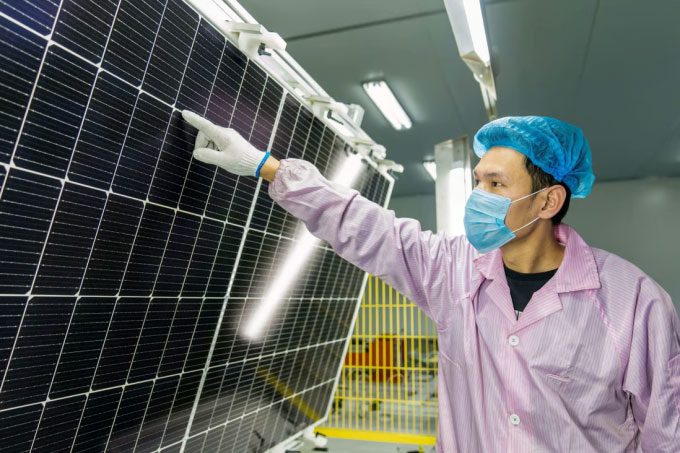With the production of 80% of the world’s solar panels, China holds a significant advantage in the renewable energy sector.
According to the International Energy Agency (IEA), spending on solar energy production reached $380 billion this year. This marks the first time in history that this sector has surpassed spending on oil extraction, which amounted to $370 billion.
Experts note that the world is shifting from fossil fuels to renewable energy, particularly solar energy. Meanwhile, most photovoltaic panels are currently produced in China. The IEA reports that China accounts for 80% of the total solar panels manufactured globally. When considering the supply chain, the country’s impact is even more pronounced: it produces 85% of photovoltaic components, 88% of polysilicon—the material that converts sunlight into electricity—and up to 97% of the thin film that protects the solar cell core.

Workers at GCL Poly Energy—one of the largest solar panel manufacturers in the world—are inspecting panels at a factory in Jiangsu. (Photo: AFP).
China’s dominance in solar energy has developed rapidly. In 2005, Europe led the race, with Germany alone accounting for one-fifth of global solar panel production. Just five years later, the region was still installing a lot of solar electricity but producing less. This year, for every ten solar panels sold in the market, eight are produced in China.
The rapid development of solar energy in China is largely due to the country’s supportive policies, such as low capital and costs, fast project approvals, protection of domestic companies from foreign competition, low labor costs, a vast supply chain network, and high domestic demand. These factors have helped China establish itself as a manufacturing powerhouse that is hard to topple.
A Strategic Game Piece
“The geopolitical significance of solar energy becoming an alternative to oil is enormous,” stated Graham Allison, a professor at Harvard University, in an interview with FT. “Why has the Middle East become the center of the arena over the past decade? Because the countries there are major suppliers of oil and gas—the energy sources for the 20th-century economy. If, in the next decade, solar energy replaces a significant portion of oil, who will suffer the most and who will win?”
The United States and Europe have committed to halving greenhouse gas emissions by 2030 and achieving net-zero emissions by 2050. Last September, Jake Sullivan, the U.S. National Security Advisor, emphasized that green technology is one of three particularly important factors alongside semiconductors and artificial intelligence—two areas where the U.S. is restricting China through bans. Nevertheless, observers believe the solar panel sector will be significantly different.
Under the Inflation Reduction Act, signed by President Joe Biden last August, the U.S. will allocate $369 billion for green energy over the next ten years, including $100 billion in grants for solar panel manufacturers and another $100 billion in tax incentives. Europe is also trending towards increasing investment in renewable energy, primarily for solar energy.
However, the European solar energy industry currently relies heavily on imports from China. According to Alicia Garcia-Herrero, a senior fellow at the Bruegel think tank in Brussels, Europe needs to collaborate with the U.S. to create a “optimal green zone.”
“If not, what will happen? Europe will continue to import everything from China, from storage batteries to solar panels, while the U.S. will create its own ecosystem,” Garcia-Herrero told Bloomberg.
Despite this, according to Allison, the U.S., Europe, and China all inhabit the same planet. Emissions do not affect individual countries but have a global impact, to the extent that no one will be able to survive in the future.
“To ensure the survival of their citizens, leaders of these countries will have to find ways to cooperate alongside competition,” Allison stated.




















































